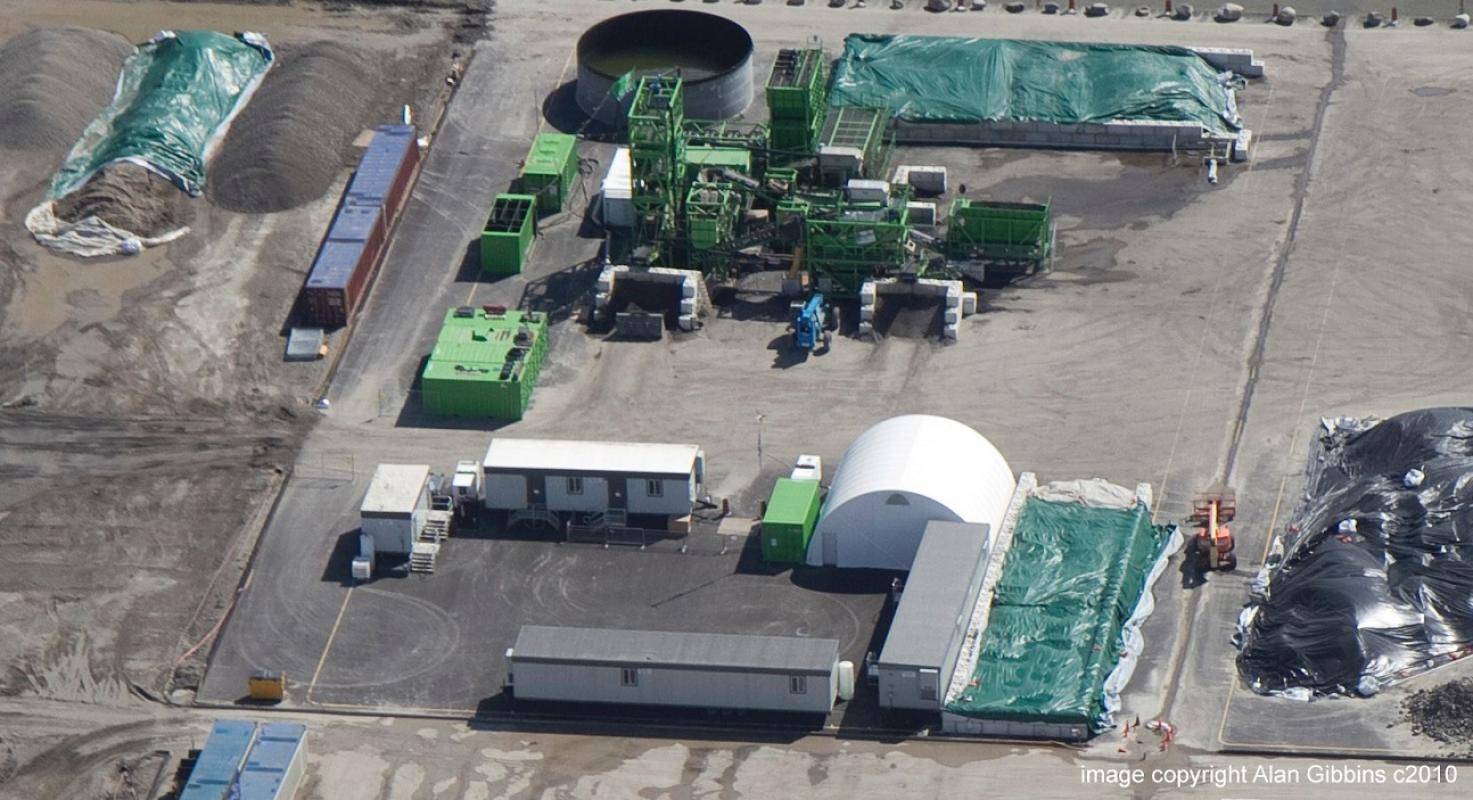Pilot Soil Recycling Facility
In an effort to raise the bar on brownfield remediation, Waterfront Toronto established a soil recycling facility in the Port Lands.
Waterfront Toronto established the Port Lands Soil Recycling Facility in July 2010 as part of our soil management strategy and overall commitment to sustainability. The objective was to determine the viability of treating and reusing impacted soil as an alternative to the traditional "dig-and-dump" disposal of brownfield soil.
The latest and best technologies available were used to treat contaminated soils including soil washing, complemented by field trials of a number of other cutting-edge technologies.
Soil recycling is innovative in the Ontario context, and has only been used rarely in a few Canadian locations.
Quick Facts
Soil Recycling Facility
Prior to committing to a full scale soil recycling facility, Waterfront Toronto decided to conduct a pilot. The goals of the pilot were to identify the range of treatment options and costs; confirm that impacted soil can be treated to standards set by the Ministry of the Environment Brownfield Regulation; and showcase treatment technologies.
Following an international request for proposals and a rigorous review, two teams - DEC, in partnership with Coffey Geotechnics, and Tetra Tech/Stuyvesant Environmental Contracting - were chosen to conduct the soil recycling pilot. Both teams operate similar facilities in Europe and the United States.
After consulting the public and stakeholders and obtaining all necessary Ontario Ministry of the Environment approvals, the pilot facility was set up in the summer of 2010. In the fall, the operators processed approximately 20,000 cubic metres of soil from Toronto's waterfront employing soil washing, complemented by field trials of a number of other cutting-edge technologies.
The pilot was a first step in the larger plan to treat contaminated soil to an environmental condition that allows it to be reused in future residential and commercial areas.
In April 2012, Waterfront Toronto received a $350,000 Green Municipal Fund federal grant in support of the pilot recycling facility. Upon completion of the pilot facility, Waterfront Toronto chose Green Soils, an industry leader with over 20 years of experience managing contaminated soil, as the soil recycling facility operator in the Port Lands.
Why Recycle Soil?
Soil recycling is an opportunity to turn contaminated soil into a resource instead of a liability. Recycling soil has the potential to change the way impacted soil is managed in Ontario.
The revitalization of Toronto’s waterfront is one of the largest urban brownfield remediation projects in the world. Revitalization of the waterfront area depends on the ability to deal with soil that has been impacted by decades of industrial uses, and by infilling long ago when environmental standards were not as stringent as today.
Waterfront Toronto anticipates that it will need to manage approximately 2,000,000 cubic metres of contaminated soil over the next 10 to 20 years. By recycling waterfront soil, Waterfront Toronto would be treating soil near its source, diverting soil from landfill, and providing a source of treated soil that can be used in waterfront revitalization projects.
Soil treatment and reuse prevents contaminated soil from being disposed of in landfill, which reduces Green House Gas (GHG) emissions by reducing transport needs (trucks are major GHG contributors), as well as revitalization costs by decreasing the quantity of clean soil required for use in waterfront revitalization projects.
Soil Recycling Results
As part of the pilot project, Waterfront Toronto commissioned a study to understand and quantify the benefits of soil recycling versus conventional disposal. The findings were striking.
The study demonstrated that Waterfront Toronto’s pilot project reduced greenhouse gas emissions by 36kg/tonne of soil moved, for a an estimated savings of $18.50 per tonne, which is a projected savings of $65M over the life of the long-term facility. The study also projected that a full-scale soil recycling facility would have significant environmental and economic benefits: associated truck travel would be reduced by about 80%, resulting in reduced road maintenance, fewer traffic accidents and reduced traffic noise; associated greenhouse gas emissions would be reduced by about 75%, resulting in reduced societal, environmental and health costs; and recycling soil would reduce the need for landfill capacity and new aggregate.
VIDEO: Pilot Soil Recycling Facility
Learn more about the pilot project and how soil washing works.
WATCH THE VIDEO
How is the environment protected?
Every effort is made to ensure that the pilot soil recycling facility is operated in a way that is protective of human health and the natural environment.
Before receipt at the pilot facility, soils undergo pre-testing to determine quality, and the levels and types of contamination. Soils containing hazardous waste are not accepted at the facility, but are disposed of at anOntario Ministry of the Environment (MOE) licensed hazardous waste landfill facility.
Dust control, air monitoring, water, and runoff control measures are in place as part of the pilot’s operational procedures.
In addition to the measures noted above, the Unwin site is managed by The Cannington Group, a full service contractor serving the Province of Ontario. They are responsible for facility management and maintenance services, including the management of all incoming soils, stockpiles and project records.
Cannington is also responsible for implementing the onsite health, safety and environmental management plans, including dust monitoring and management, emission control, and the construction, management and monitoring of the storm water management pond, the mobile water treatment unit, and the silt fence that controls potential runoff from the site.
As Site Manager, they developed and managed the overall Health and Safety Plan, including the visitor training program and traffic management plan, as well as monitoring the pilot’s operators to ensure compliance with all health, safety and environmental requirements.
For more information about the planning and future development of the Port Lands and the Don Mouth Naturalization project, visit PortLandsTO.ca

